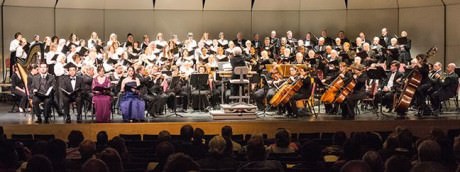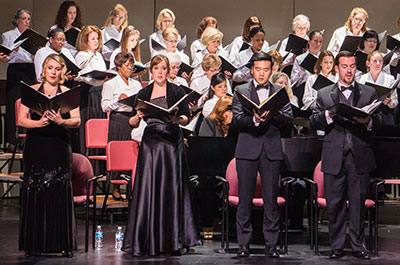On Saturday October 24, 2015 the Columbia Pro Cantare Choral group, lead by Conductor Frances Motyca Dawson, opened their 39th Season with Northern Lights, performed at the Jim Rouse Theatre for the Performing Arts.
The pieces selected Saturday night were from composers hailing from Scandinavia and Russia. This included the most famous of the group: Jean Sibelius (1865-1957) and Evard Grieg (1843-1907). It also included some lesser known Scandinavians, Johan Helmich Roman (1694-1758) and Dietrich Buxtehude (c.1637-1707). Rounding out the concert was music from the more recent Wilhelm Stenhammar (1871-1927), Carl Nielsen, (1865-1931) and Alexander Glazunov (1865-1936).

All the above were very patriotic, and although were influenced by the rest of European composers, they tried to retain ties to their Nordic roots and their pride in their homelands.
The first piece was “Concerto for Oboe d’amore in D Major” by the Swede, Johan Helmich Roman, performed by the Howard County Orchestra, which featured Sandra Gerster Lisicky, on the oboe d’amore (the mezzo-soprano of the oboe family) and Donald Fries on the organ. The piece was light and bouncy, especially the rondo. Lisicky did an exemplary job and had me loving the oboe sound by the end.
The vocals by the Pro Cantare Chorus are always an anticipated part of every concert. Their first choral piece sung with the Howard County Orchestra with Donald Fries on the organ, was “Canata: Der Herr ist mit mir, cantata for choir, BuxWV15”, by the Dane Dietrich Buxtehude. It showcased the beautiful harmonies of the voices of the chorus. It ended with“Alleluia!”, which expressed the joy and faith.
The Pro Cantare Chamber singers stepped forward for the next trio of musical numbers: “Glade of Tuoni” and “What the Thrush Toils For/Min rastas raataa, JS 129,” by the Finnish Sibelius and “September (from Three Choruses on Poems by J. P. Jacobson, c. 1890,” written by Wilhelm Stenhammar from Sweden. All three pieces reflected a more aesthetic or natural sound with the final piece depicting the feel of autumn both visually and audibly, which was created by the fine interpretation of Frances Montoya Dawson and the singers.
“Wedding Day” by the famous Norwegian Edvard Grieg, was a piano solo by Allison Gatewood. She captured the composer’s range of emotion as this was written for Grieg’s 25th wedding anniversary. The composition is mostly joyful, but like with any long-term relationship, Grieg’s reflections showed passion, anger and, of course, romantic love.
The Chorus opened after Intermission with “Two Motets, Op.55: Benedictus Dominus and Dominus regit me” written by Carl Nielsen in Denmark in 1929. There are definitely roots in Bach and Handel in this more religious piece. Again without any musical backing, the Chorus does an excellent job blending their rich vocal range.
Three duets for violin and piano followed: “Romance, Op. 78, No. 2 (from Four Pieces)” by Sibelius; “Mediation, Op. 32 for violin and piano” by the Russian Alexander Glazunov; and “Romance & Humoresque, “Two Fantasy Pieces,” Op 2,” for violin and piano, by Nielsen. They were movingly performed by violinist Ronald Mutchnik, and pianist Allison Gatewood. I could visualize the real Northern Lights in the lighter sounds of the first two pieces. The third was a more haunting number.
We were then treated to the marvelous voice of soprano Rachel Blaustein, accompanied by Allison Gatewood on piano as she sang “Sibelius’ Four Songs from Op.50.” The first, “In the Field a Maid Sings,” is a mournful song in both words and music. “Anxious Heart, reflected some to the Germanic feeling of the poetry but was also very sensual. “The Silent City” is a song of hope through kindness, and the final song – “Song of the Roses” is full of natural elements including the bursting forth of springtime. Blaustein finished with Glazunov’s “Nina’s Song,” Text: M. Lermontov, and conveyed all the Russian angst including jealousy in the piece.
The night ended with two more musical selections by Sibelius: “Festive March, JS 105” which he wrote for a graduation ceremony (a duty he had when teaching in Helsinki) and his most famous piece “Finlandia Hymn, adapted from Op.26.” Both were presented by the Pro Cantare Chorus. The first was a toe-tapping piece and, of course, “Finlandia” was a very moving piece mirroring Sibelius’ national pride. The composition has been used in hymns, national songs and anthems. It was an outstanding end to our “trip” to Northern European and reminded us that the Germans, Italians, Austrians and French were not the only talented composers in Europe.

After the show we were treated to a wonderful reception that included many home made Scandinavian pastries, delectably keeping with the theme of the evening.
The Columbia Pro Cantare will be performing several more times this season. If you have never heard them do Handel’s Messiah, you should pencil in December 6, 2015, for their performance of this holiday favorite.
For further information on their 2015-2016 season, go to their website.




